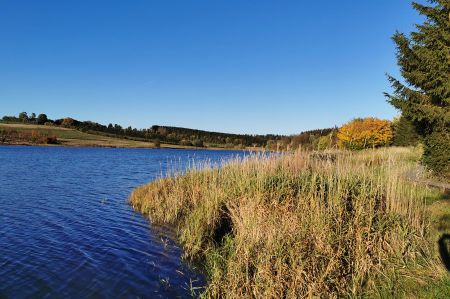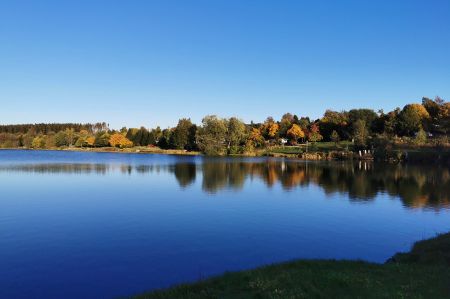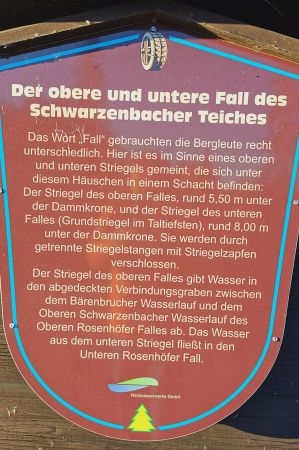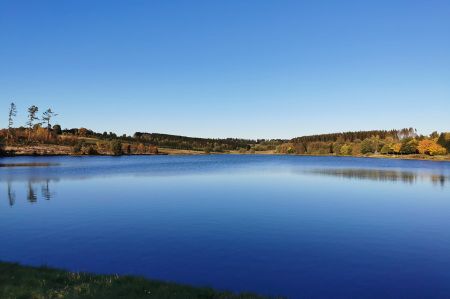Pixhaier & Schwarzenbacher pond at the Prahljust campsite
- Written by Portal Editor
Traveling regionally again, this time we ended up in the Upper Harz near Clausthal-Zellerfeld at the Prahljust campsite, where we not only wanted to explore the cycling and hiking trails of the Harz, but also specifically the water supply for driving water wheels to generate energy for the former wanted to take a look at the Upper Harz ore mines.
During previous stays we had already noticed the numerous water areas, which are smaller than the well-known reservoirs such as the Oker or Söse dams, but are much more numerous in the landscape.
The Pixhaier pond is right next to the Prahljust campsite
 The Pixhaier Teich was built around 1647 as the Pixhaier Mühlenteich and its "dam wall" was raised at least once. It was also a mining pond from the start. Today it is 244 meters long and a maximum of 8.75 meters deep, storing up to 288,000 cubic meters of water.
The Pixhaier Teich was built around 1647 as the Pixhaier Mühlenteich and its "dam wall" was raised at least once. It was also a mining pond from the start. Today it is 244 meters long and a maximum of 8.75 meters deep, storing up to 288,000 cubic meters of water.
About 25 meters from the airside embankment edge of the dam, a smaller dam runs parallel to the pond dam. This sealed off the so-called counterbalance. Open today, it used to dam the water discharged from the pond above the lowest-lying Striegel. In this way, it could be introduced into the ditch in a targeted manner. There are counterbalances of this type on numerous pond dams in the Upper Harz.
Next to it is the Schwarzenbacher pond
 The Schwarzenbacher pond was probably created at the beginning of the 17th century because it broke in July 1606, probably during the so-called first dam. The breach caused damage of 600 Malters of Roastwood and 18 Shocks of Driftwood. The dam was once raised, as evidenced by an outflow ditch that is still visible.
The Schwarzenbacher pond was probably created at the beginning of the 17th century because it broke in July 1606, probably during the so-called first dam. The breach caused damage of 600 Malters of Roastwood and 18 Shocks of Driftwood. The dam was once raised, as evidenced by an outflow ditch that is still visible.
With a length of 140 meters and a maximum height of 7.40 meters, it now holds 174,000 cubic meters of water. The pond feeds the upper Rosenhöfer fall, the overflowing water flows through the lower Schwarzenbach watercourse into the so-called lower Rosenhöfer waterfall. Both falls are chains of watercourses that have replaced the Lower and Upper Rosenhöfer Kunstgraben to improve winter operations.
Water for storage also from collecting ditches
 The reservoirs were originally built to store water to drive water wheels to supply energy to the Upper Harz ore mines. With these water wheels, the operation of the pumps, the conveyor systems, the stamp mills and from 1820 also the driving skills were ensured. The ponds initially obtained the water for storage from their natural catchment area, which was then often considerably enlarged by additional collecting ditches.
The reservoirs were originally built to store water to drive water wheels to supply energy to the Upper Harz ore mines. With these water wheels, the operation of the pumps, the conveyor systems, the stamp mills and from 1820 also the driving skills were ensured. The ponds initially obtained the water for storage from their natural catchment area, which was then often considerably enlarged by additional collecting ditches.
Today the ponds are operated for reasons of monument protection, landscape conservation, nature conservation and recreation. Some ponds are used for flood protection, some other ponds are used for drinking water production. The ponds are operated by the Harzwasserwerke, which also operate six modern dams in the Lower Saxony part of the Harz Mountains.
Please read as well:
